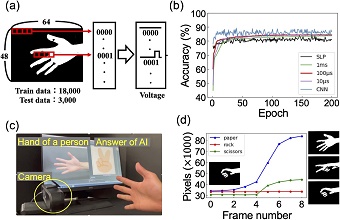Volume 67, Issue 11
Special Feature : Physical Reservoir Computing
Displaying 1-13 of 13 articles from this issue
- |<
- <
- 1
- >
- >|
Preface
-
Article type: Preface
2024Volume 67Issue 11 Pages 519
Published: November 10, 2024
Released on J-STAGE: November 10, 2024
Download PDF (412K)
Special Feature : Physical Reservoir Computing
-
Article type: Introduction
2024Volume 67Issue 11 Pages 520
Published: November 10, 2024
Released on J-STAGE: November 10, 2024
Download PDF (208K) -
 Article type: Current Topics
Article type: Current Topics
2024Volume 67Issue 11 Pages 521-526
Published: November 10, 2024
Released on J-STAGE: November 10, 2024
Download PDF (5596K) -
Article type: Current Topics
2024Volume 67Issue 11 Pages 527-532
Published: November 10, 2024
Released on J-STAGE: November 10, 2024
Download PDF (3386K) -
Article type: Current Topics
2024Volume 67Issue 11 Pages 533-538
Published: November 10, 2024
Released on J-STAGE: November 10, 2024
Download PDF (4362K) -
Article type: Current Topics
2024Volume 67Issue 11 Pages 539-544
Published: November 10, 2024
Released on J-STAGE: November 10, 2024
Download PDF (1667K) -
Article type: Current Topics
2024Volume 67Issue 11 Pages 545-550
Published: November 10, 2024
Released on J-STAGE: November 10, 2024
Download PDF (1793K) -
Article type: Current Topics
2024Volume 67Issue 11 Pages 551-556
Published: November 10, 2024
Released on J-STAGE: November 10, 2024
Download PDF (3497K) -
Article type: Current Topics
2024Volume 67Issue 11 Pages 557-562
Published: November 10, 2024
Released on J-STAGE: November 10, 2024
Download PDF (6493K)
Regular article
-
Article type: Regular article
2024Volume 67Issue 11 Pages 563-568
Published: November 10, 2024
Released on J-STAGE: November 10, 2024
Download PDF (1233K)
Science Café
-
Article type: Science Café
2024Volume 67Issue 11 Pages 569-571
Published: November 10, 2024
Released on J-STAGE: November 10, 2024
Download PDF (1934K)
Research Abroad
-
Article type: Science Café
2024Volume 67Issue 11 Pages 572-573
Published: November 10, 2024
Released on J-STAGE: November 10, 2024
Download PDF (1015K)
News & Trends
-
Article type: News & Trends
2024Volume 67Issue 11 Pages 574
Published: November 10, 2024
Released on J-STAGE: November 10, 2024
Download PDF (329K)
- |<
- <
- 1
- >
- >|








